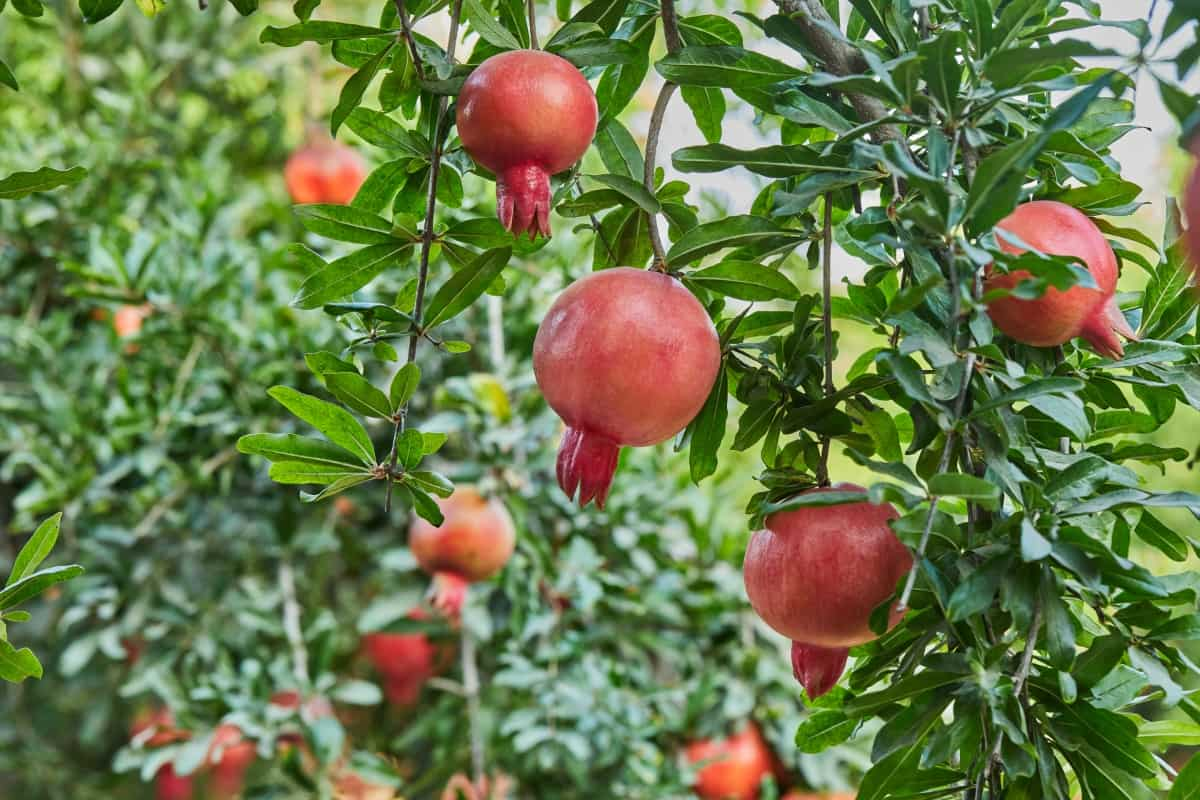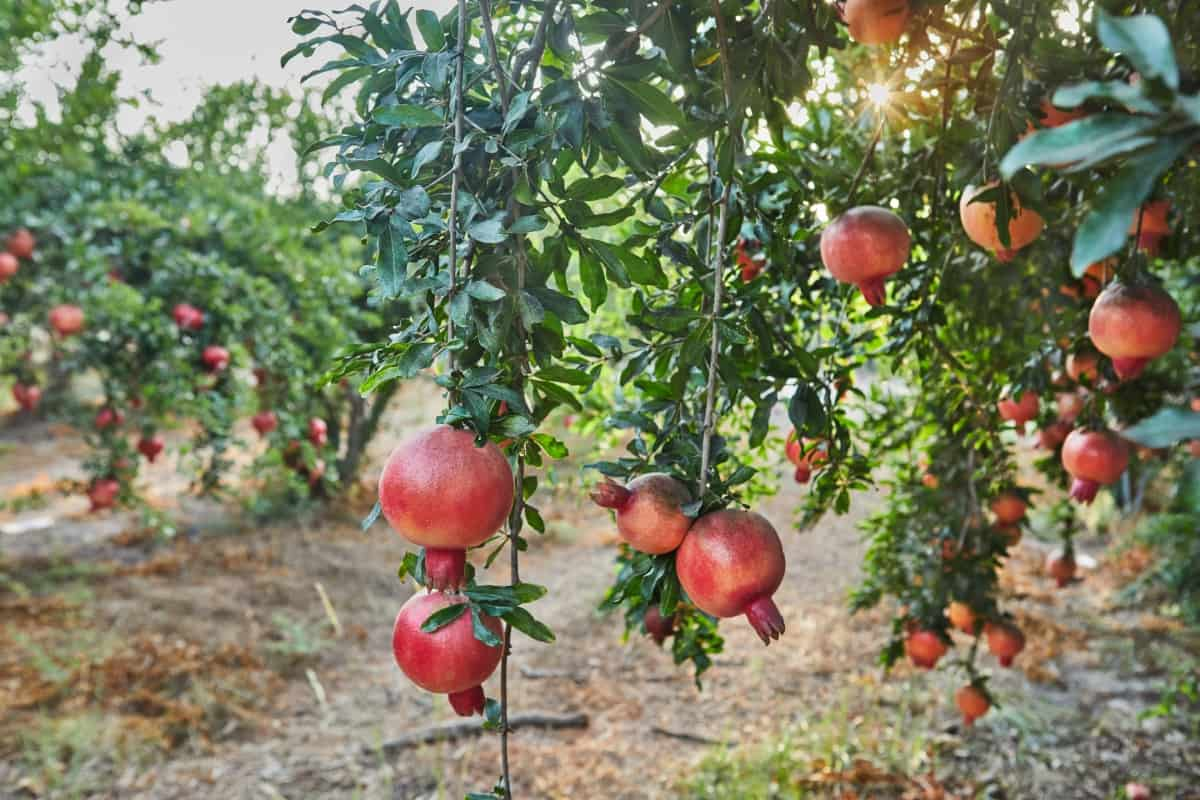Pruning is essential for maintaining pomegranate trees’ health and productivity. By removing dead or diseased branches, improving airflow, and shaping the tree, pruning helps promote better fruit production and overall growth. However, knowing the right time to prune is crucial to ensure the tree’s well-being. This document will provide valuable information on when to prune your pomegranate tree, including the best time, schedule, season, and techniques.

When to Prune Pomegranate Tree
Best Time to Prune a Pomegranate Tree
The best time to prune a pomegranate tree is during winter, preferably in late winter or early spring. During this time, the tree can recover before the onset of new growth. Removing dead, damaged, or diseased branches and crossing or crowded branches is important. Additionally, thinning the canopy and shaping the tree can improve air circulation and sunlight penetration, ultimately promoting healthier growth and fruit production.
When Should I Prune My Pomegranate Tree?
Pruning Young Pomegranate Trees: Training and shaping the tree’s structure during the first few years is essential for newly planted or young pomegranate trees. Pruning should be conducted during the dormant season to encourage the development of a well-balanced framework.
Once the pomegranate tree reaches maturity, the pruning approach changes. At this stage, the emphasis is on maintaining the tree’s shape and removing any dead or unproductive wood. Remove any weak or spindly branches, as they are unlikely to bear quality fruit.
Pruning Schedule for Pomegranate Trees
Pomegranate tree pruning should involve thinning out weak, awkward, diseased, crossed-over branches and suckers by cutting them to their bases. You should do this every year. By cutting pomegranates in this way, their natural form can be encouraged, air and light are allowed to enter the center, and disease vectors are reduced.
You should prune the branches lightly at the ends – just enough to maintain a balanced shape. The purpose of pruning pomegranate trees is to produce fruit by increasing the number of exterior branches and fruit spurs that form fruiting wood. Allow the smaller side shoots to form in the spring by pruning the exterior branches. It is more likely that this new growth will produce flowering and fruiting buds.
Ideal Season for Pruning Pomegranate Trees
A pomegranate tree is best pruned, usually in late winter or early spring during the dormant. Pruning during this period allows the tree to recover from the cuts and promotes healthy regrowth. This is the ideal time as the trees are not actively growing, making it easier to shape and control their growth. Pruning during this period also minimizes the risk of disease transmission, as wounds heal more quickly when the tree is not actively producing sap.
When to Trim a Pomegranate Tree
Trimming during this dormant season helps to shape the tree, remove dead and damaged branches, and maintain its overall structure. During this dormant period, you should focus on removing any dead, damaged, or diseased branches. These should be pruned back to healthy wood, making clean cuts just above a bud or lateral branch. Additionally, you can thin out overcrowded areas within the canopy to improve air circulation and sunlight penetration, which benefits the tree’s overall health.
It is important to note that pomegranate trees tend to produce suckers or water sprouts, which are shoots that grow from the tree’s base or along the main branches. These suckers should be removed promptly as they can divert energy from fruit production. Removing suckers will help maintain the tree’s shape and direct its energy toward fruiting.
Timing of Pruning for Pomegranate Trees
The best time to prune pomegranate trees is during the dormant season, usually in late winter or early spring. During this time, pruning allows the tree to recover before the growing season begins. Wait until the frost threat passes, as pruning can stimulate new growth susceptible to damage from freezing temperatures.
In case you missed it: How to Prune Pepper Plants: Best Time to Trim, Tools and Techniques to Cut Back for Maximum Yield

During the dormant season, pruning pomegranate trees should involve the removal of dead, damaged, or diseased branches. These are identified by their lack of foliage, discoloration, or signs of decay. Removing these branches improves the tree’s appearance and reduces the risk of disease spread and pest infestations.
Pruning Guidelines for Pomegranate Trees
Timing: It is best to prune pomegranate trees during late winter or spring before new growth begins.
Tools: Use clean and sharp pruning tools to make clean cuts. This helps reduce the risk of infection. Recommended tools include hand pruners, loppers, and a pruning saw for larger branches.
Remove dead or diseased branches: Start by identifying any dead or diseased branches. These are identified by their lack of foliage, discolored bark, or signs of decay. Cut these branches at the base, making sure to remove them completely.
Thin-out crowded branches: Evaluate the tree’s overall structure and identify branches crossing or rubbing against each other. Select the weaker one and remove it at its point of origin.
Maintain an open center: Pomegranate trees naturally have an open center, which allows sunlight to reach the inner branches. Remove any branches growing towards the tree’s center, as they can block sunlight and hinder fruit production.
Control Size and Height: If your pomegranate tree is becoming too large or tall, you can prune it to maintain a manageable size. Cut back the branches to a desired height or length, maintaining a balanced shape. Optimal Period for Pruning a Pomegranate Tree
When is the Right Time to Prune a Pomegranate Tree?
Ideally, pruning should be done during the dormant season, in late winter or early spring. The tree is not actively growing and has shed its leaves during this time. Pruning during this time allows the tree to focus on healing and regenerating new growth once the weather warms up.
While late winter or early spring is generally the recommended time for pruning pomegranate trees, there are a few exceptions. If your tree has suffered frost damage, it is best to delay pruning until after the last frost date in your area. Pruning too early after frost can potentially cause further damage to the tree.
Seasonal Pruning Recommendations for Pomegranate Trees
Winter Pruning (Late December to Early February)
- Remove dead or damaged branches: Start by identifying and removing branches that appear lifeless or diseased. This prevents the spread of diseases and encourages new growth.
- Thin out crowded branches: Look for branches crossing or rubbing against each other.
Spring Pruning (Late March to Early April)
- Remove suckers: These shoots grow from the tree’s base or rootstock.
- Prune back vigorous growth: If your pomegranate tree has experienced much new growth during the winter, selectively prune back some long branches to maintain the desired shape and prevent overcrowding. Remove any remaining dead or damaged branches.
Summer Pruning (After Fruit Harvest)
- Remove any dead or diseased branches: Inspect the tree for branches that have died or show signs of disease.
In case you missed it: When to Prune a Redbud Tree: How to Prune a Redbud Sapling

Conclusion
The best time to prune a pomegranate tree is late winter or spring before new growth begins. Following a regular pruning schedule and adhering to the guidelines mentioned above will help maintain your pomegranate tree’s health, shape, and productivity.
- Feed Your Flock for Less: Top 10 Tips to Save on Chicken Feed
- Ultimate Guide to Ossabaw Island Hog: Breeding, Raising, Diet, and Care
- Hatching Answers: The Top 10 Reasons Your Chickens Aren’t Laying Eggs
- Eggs and Economics: Breaking Down the Cost of Raising Backyard Chickens
- Defend Your Greens: Proven Methods to Keep Iguanas Out of Your Garden
- Ultimate Guide to Cinnamon Queen Chicken: A Comprehensive Guide for Beginners
- Ultimate Guide to California Tan Chicken: Breeding, Raising, Diet, Egg-Production and Care
- Ultimate Guide to Marsh Daisy Chicken: Breeding, Raising, Diet, and Care
- 10 Types of Chicken Farming Businesses You Can Start for Profits